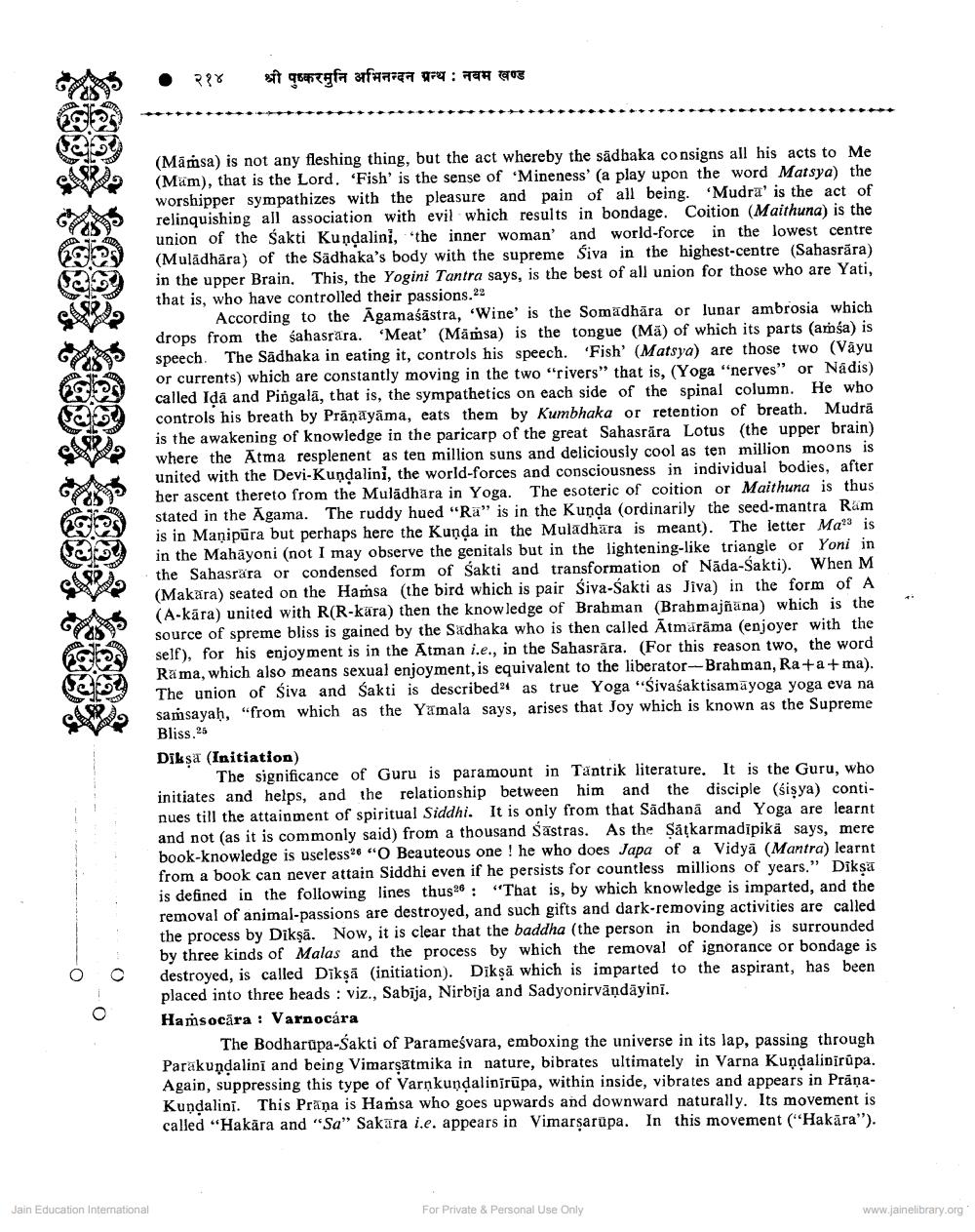Book Title: Philosophy of Tantrik Yoga Sadhna Author(s): Vaishishtha Narain Tripathi Publisher: Z_Pushkarmuni_Abhinandan_Granth_012012.pdf View full book textPage 5
________________ २१४ श्री पुष्करमुनि अभिनन्दन ग्रन्थ : नबम खण्ड 692 (Māṁsa) is not any fleshing thing, but the act whereby the sādhaka consigns all his acts to Me (Mam), that is the Lord. 'Fish' is the sense of 'Mineness' (a play upon the word Matsya) the worshipper sympathizes with the pleasure and pain of all being. Mudra' is the act of relinquishing all association with evil which results in bondage. Coition (Maithuna) is the union of the Sakti Kundalini, the inner woman' and world-force in the lowest centre (Muladhara) of the Sadhaka's body with the supreme Siva in the highest-centre (Sahasrāra) in the upper Brain. This, the Yogini Tantra says, is the best of all union for those who are Yati, that is, who have controlled their passions.22 According to the Agamaśāstra, Wine' is the Somadhara or lunar ambrosia which drops from the sahasrara. "Meat' (Māṁsa) is the tongue (Mā) of which its parts (amśa) is speech. The Sadhaka in eating it, controls his speech. 'Fish' (Matsya) are those two (Vāyu or currents) which are constantly moving in the two "rivers" that is, (Yoga "nerves" or Nádis) called Ida and Pingalā, that is, the sympathetics on each side of the spinal column. He who controls his breath by Pränāyāma, eats them by Kumbhaka or retention of breath. Mudrā is the awakening of knowledge in the paricarp of the great Sahasrara Lotus (the upper brain) where the Atma resplenent as ten million suns and deliciously cool as ten million moons is united with the Devi-Kundalini, the world-forces and consciousness in individual bodies, after her ascent thereto from the Muladhara in Yoga. The esoteric of coition or Maithuna is thus stated in the Agama. The ruddy hued "Ra" is in the Kunda (ordinarily the seed-mantra Ram is in Manipūra but perhaps here the Kunda in the Muladhara is meant). The letter Ma 3 is in the Mahayoni (not I may observe the genitals but in the lightening-like triangle or Yoni in the Sahasrara or condensed form of Sakti and transformation of Nāda-Sakti). When M (Makara) seated on the Hamsa (the bird which is pair Siva-Śakti as Jiva) in the form of A (A-kāra) united with R(R-kara) then the knowledge of Brahman (Brahmajñana) which is the source of spreme bliss is gained by the Sadhaka who is then called Ātmaräma (enjoyer with the self), for his enjoyment is in the Atman i.e., in the Sahasrara. (For this reason two, the word Rama, which also means sexual enjoyment, is equivalent to the liberator-Brahman, Ra+a+ma). The union of Siva and Śakti is described 24 as true Yoga "Sivasaktisamayoga yoga eva na samsayah, "from which as the Yamala says, arises that Joy which is known as the Supreme Bliss.25 Diksa (Initiation) The significance of Guru is paramount in Tantrik literature. It is the Guru, who initiates and helps, and the relationship between him and the disciple (sisya) continues till the attainment of spiritual Siddhi. It is only from that Sadhana and Yoga are learnt and not (as it is commonly said) from a thousand Sastras. As the Saçkarmadīpikä says, mere book-knowledge is useless 26 "O Beauteous one ! he who does Japa of a Vidya (Mantra) learnt from a book can never attain Siddhi even if he persists for countless millions of years.” Diksa is defined in the following lines thus26 : "That is, by which knowledge is imparted, and the removal of animal-passions are destroyed, and such gifts and dark-removing activities are called the process by Dikşā. Now, it is clear that the baddha (the person in bondage) is surrounded by three kinds of Malas and the process by which the removal of ignorance or bondage is destroyed, is called Diksā (initiation). Diksā which is imparted to the aspirant, has been placed into three heads : viz., Sabīja, Nirbija and Sadyonirvändäyini. Hassocāra : Varnocára The Bodharüpa-Sakti of Paramešvara, emboxing the universe in its lap, passing through Parakundalini and being Vimarşatmika in nature, bibrates ultimately in Varna Kundalinirūpa. Again, suppressing this type of Varnkundalinirūpa, within inside, vibrates and appears in PranaKundalini. This Präna is Hamsa who goes upwards and downward naturally. Its movement is called “Hakāra and “Sa” Sakara i.e. appears in Vimarsarupa. In this movement ("Hakāra"). OC Jain Education International For Private & Personal Use Only www.jainelibrary.orgPage Navigation
1 ... 3 4 5 6 7 8 9
